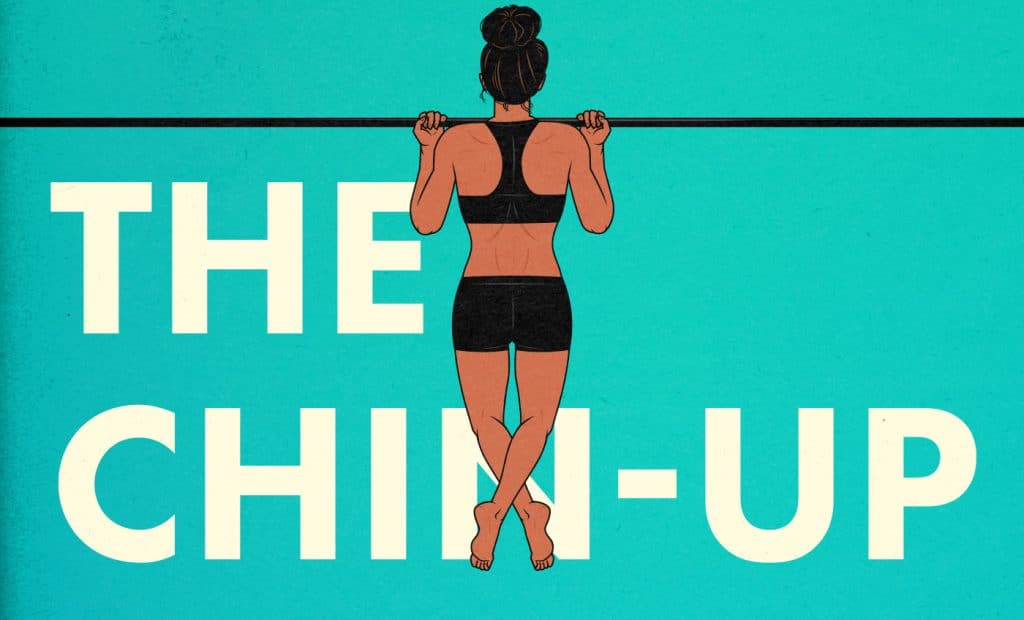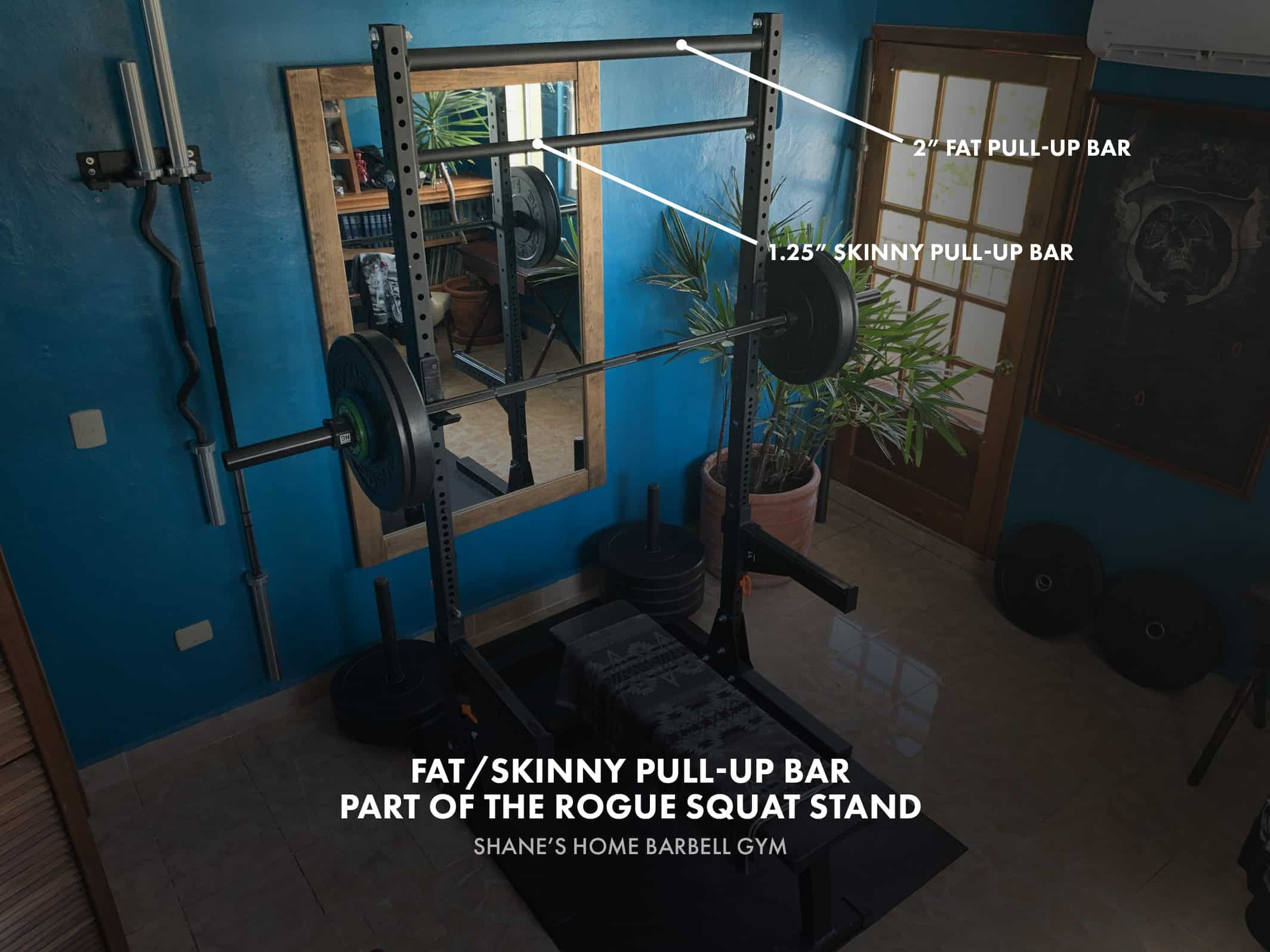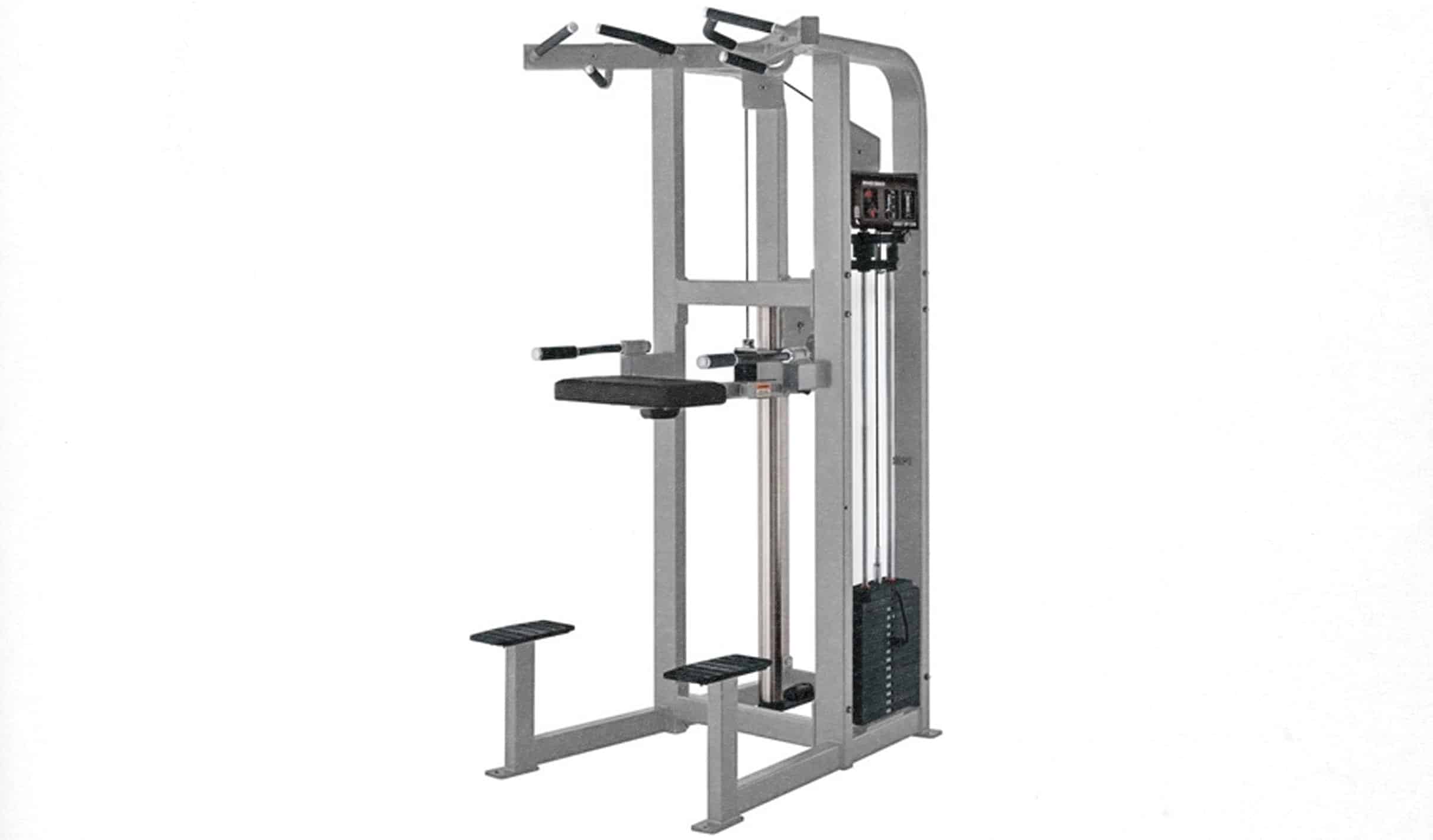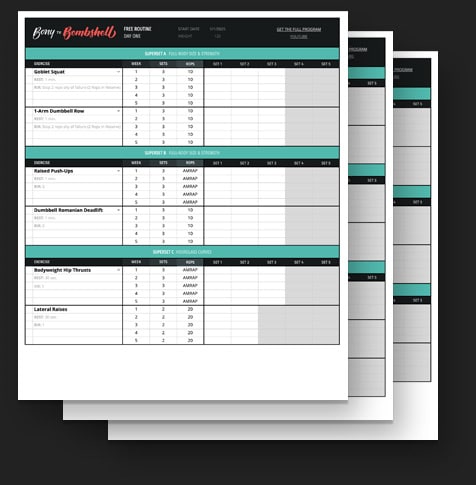
Beginner Chin-Up Guide for Women: Get Your First Chin-Up
Shane wrote an extensive chin-up guide over on Outlift, but we also wanted to write a beginner guide for women. Many women struggle to get their first chin-up. There are reliable ways to get you there.
There are few exercises more impressive than being able to do a full chin-up from a dead hang. We’ve been helping women learn how to gain muscle for ten years now, and we can’t tell you how many times we’ve been asked for directions on how to do a full chin-up.
Most female beginners can’t do any chin-ups. They have impressive mobility and often quite a lot of lower-body strength, but chin-ups are hard. They won’t be for long.
Preparing for Chin-Ups
Getting A Chin-Up Bar
This is an obvious step—you need a chin-up bar. If you’re hitting the gym, you’ve already got this covered, and you may even have access to an assisted pull-up machine (more on this later.)
If you’re training at home, you can either get a:
- Door-mounted chin-up bar
- Permanently mounted chin-up bar
My roommate Shane once had the door-mounted chin-up bar when he first got into lifting. One day when he was doing chin-ups, the bar came off the door frame. He fell and smashed his knee onto the floor. It hurt for months and left a permanent scar on his now-crooked kneecap.
So if possible, it will be better to get a chin-up bar that is mounted more solidly. I have this Rogue P3 Pull-Up bar mounted into my basement wall.

Today, Shane has a chin-up bar with two options—fat and skinny. That’s part of his Rogue squat stand/rack. That works perfectly too.

In a pinch, you can use the door-mounted ones. They’re inexpensive, and you can tuck them away in the closet. Just be aware of the risk and to be careful. Be ready to land on your feet, not your knees.
Understanding The Chin-Up Progression
The best way to get stronger at something is to do more of it. So to get better at the chin-up, you should do more of them. More reps, more sets, and doing them often.
But here’s the problem—how do you get better at chin-ups when you can’t do one rep?
Well, we need to break it down so that we’re still practicing the chin-up movement but still able to get in some time under tension doing the exercise. So let’s take a look at how you can do this if you’re at the gym or if you’re at home.
Chin-Up Progression For Women At The Gym
If you’re at the gym and your gym has machines, it will likely have the assisted pull-up machine. It will look like this:

What you can do is set the level of resistance, the knee pad will relieve that weight of your body off your arms and back, and you can do more reps.
You will want to set a level of resistance that you can do 5 to 10 reps of chin-ups with.
For example, let’s say with the assistance level of 5, and you can do 7 chin-ups with perfect form. Great. Do 3 sets of those 7 reps at the start of your workout, and then go finish the remainder of your workout.
Over the next few workout sessions, keep trying to do more reps. Maybe you can do 8 assisted chin-ups, then 9 reps, then 10 reps. Once you hit 10 assisted chin-up reps, lower the assistance level down to 4. Then start over. Maybe you can do 6 reps at that assistance level. Great. Then start rebuilding. Over the next few workouts, once you get to 10 reps again for all 3 sets, then lower the assistance level down to 3, and so on.
With time and effort, one day, you will slowly lower the assistance needed until you need any assistance at all, and you can do a full whole-range motion chin-up!
If you’re at home, you won’t have access to an assisted pull-up machine. That’s okay. You’ve still got great options.
Home Progression #1: Lowered Chin-Up (Or Negative Chin-Ups)
This is the best way to learn the chin-up. With this option, you will set up a chair (or anything that is sturdy enough to support your weight) under the chin-up bar.
Standing on the chair, grab the bar, and pretend you’re at the end position of the chin-up with your chest touching the bar.
Now depending on how strong you are, you can either lift your feet completely off the chair or, if you don’t have the strength yet, you can keep your feet on the chair but put less weight on them and shift more of that weight into your hands.
Starting at the top, lower yourself as slowly as you possibly can. Try and fight to stay up at that end position. As you get weaker and more tired, you will drop slowly. That’s okay. Fight as hard as you can. Keep breathing as you fight. When you’re at the bottom—that’s one set of lowered chin-ups done.
Try and do 3 sets like that. Rest in a couple of minutes in between, and fight for your life. And over the next few weeks, you’ll notice you can hold yourself at the top for a long time. Holding yourself at the top is technically called the chin-up ISO exercise.
Here’s a video of Marco coaching Marielle to do the lowered chin-up exercise.
Home Progression #2: The Resistance Band Assistance
Similar to using the assisted pull-up machine at the gym, you can use resistance bands to take some weight away from your body. You can take a resistance band in a loop and tie it around the pull-up bar. Then you can hook your knee into it, and it will relieve some weight from your body.
The stronger the resistance band, the more weight it will remove and the more reps you’ll be able to do.
While this progression works, I am not the biggest fan of this method for a few reasons.
- Resistance bands cost money. You’ll need to buy a few resistance bands to get varying strengths to match where you currently are. Unless you already have some resistance bands or are planning to use them for some other part of your training, the lowered bodyweight chin-up progression works better and is free.
- The strength curve of the resistance band is wonky. Exercise bands make the bottom of the lift easier without making the top of the lift harder. That isn’t very good for building muscle, and it can make it harder to develop the strength you need at the bottom of the lift.
If this variation of the chin-up progression sounds interesting to you, you can watch a solid demonstration of it on Youtube here.
The Final Result—A Full Chin-Up From A Dead Hang
Here’s a video of Simone doing a couple of full range-of-motion chin-ups.
Practice Proper Chin-Up Form And The Full Range Of Motion
Grip and Hand Position
The chin-up is when you have a “supinated” or otherwise known as the underhand grip, with your palms facing towards you. This grip engages your biceps, making it easier for female beginners compared to the bodyweight overhand pull-up. Your hands should be about shoulder-width apart, whatever feels most comfortable to you.
Proper Form And Muscle Engagement
Chin-ups hit your back muscles, specifically the latissimus dorsi (lats) and rhomboids. But your biceps and forearms will also get a good amount of work. You also want to make sure that you keep your core braced and to not let your abs sag.
- Lats: Ensure your lats are activated by focusing on keeping your chest up and shoulders down as you initiate the movement.
- Biceps: Your biceps will help in bending your elbows and pulling your body up. Allow them to assist but not dominate the movement.
- Forearms: Grip strength is crucial for chin-ups. Engaging your forearms will help you maintain a strong grip on the bar.
- Core: Engage your core muscles to stabilize your body and maintain proper posture throughout the movement.
Performing the Lowered Chin-Up
- Top Position. Stand on the chair, grab the bar with an underhanded grip, and start with your chest touching the bar.
- Lift your feet and fight. If you’re strong enough for this variation, lift your feet completely off the chair, and try and hold yourself at the top. Fight as hard as you can. Keep breathing in and out. If this is too hard, you can keep your feet on the chair lightly to help yourself.
- Control the descent. Keep your core engaged and maintain proper form as your strength slowly fades, and you fall lower and lower.
- Go down to a dead hang. As you reach the bottom, you should be as low as you can go, called the dead hang. You’ve now completed one set of the lowered chin-up. Pat yourself on the back.
As you practice and time passes, you will build strength and control in your back and biceps, and you’ll be able to hold the exercise for so long that you’ll feel your strength grow, and you can always test it out by trying a pull-up. One day, you’ll get it.
Building A Workout To See Chin-Up Progression
Okay, so we know how to do the chin-up progression in terms of the actual exercise. Now what about reps, sets, and how often should you do this?
Creating a Workout Plan To Get One Chin-Up
There’s something called exercise specificity. What this means is that you should train the thing you want to get better at.
For example, let’s say you play hockey, squatting can help you develop leg mass and leg power, but it won’t help your skating. If you want to get better at skating, you need to practice skating with skating-specific drills.
Similarly, with your chin-up goal, while squatting is healthy, don’t expect it to help your chin-ups get better. If you want to get better at chin-ups, you need to do chin-ups and practice regularly.
If you’re at home, you could even practice daily. You could do two lowered chin-ups a day and just follow through day in and day out, and you’ll get there.
If you’re at the gym and have access to the assistant pull-up machine, you could do more sets in one day and push yourself a bit more. That will require more rest, so you could give yourself a day of rest to help recover from the stimulus. So you could do 3x a week, sort of thing.
Integrating Your Chin-Up Goal Into A Female Beginner Lifting Workout
If you’re already doing a full-body lifting workout designed for women that you like, great, you can put your chin-up stuff right at the beginning. At the start of a workout, when you’re fresh, your reps will be of higher quality, as you’ll still have lots of energy in the body. As your workout drags on, you tend to accumulate what’s called garbage volume. The form isn’t as clean, and the reps aren’t challenging the muscles as well.
So you can add a couple of sets of your lowered chin-ups at the very beginning, give it your best effort, then switch to your other exercises.
Free Chin-Up Progression With Full Body Workout For Women
If you don’t have a workout, you might be interested in our full Bony to Bombshell program. A sample beginner’s workout for women, with some chin-up and back work at the beginning, could look like this:
- Lowered Chin-Ups: 2 sets of fighting as hard as you can.
- Dumbbell Row: 2 sets of 10 repetitions.
- Goblet Squats: 2 sets of 10 repetitions.
- Dumbbell Romanian Deadlift: 2 sets of 10 repetitions.
- Raised Push-ups: 2 sets of as many reps as possible (AMRAP).
- Bonus Glute work: 2 sets of glute bridges or hip thrusts
GET THE free GOOGLE SPREADSHEET OF THE
female chin-up progression with BEGINNER’S FULL-BODY WORKOUT

Get the workout as a Google spreadsheet. You’ll be able to pick from exercise alternatives, fill out the sheet, and get our beginner’s warm-up.
Plus, we’ll make sure you’re on the Bony to Bombshell newsletter, and send you all of our best women's muscle-building content.
What if you’re not seeing results after a couple of weeks?
Getting stronger takes time. But if after a few weeks of effort, you’re not seeing any progress with your chin-ups, then you can:
- Add more sets of lowered chin-ups. If you’re doing 2 sets, do 3. If you’re doing 3, do 4 sets. After four sets, you may want to try playing with workout frequency. For example, you try doing some chin-ups every day instead of 3x a week.
- Rest longer between your sets of lowered chin-ups. Try resting for 2-3 minutes between the sets to allow your strength to recuperate more.
- Try integrating some chin-up assistance exercises. These are exercises that help work similar muscles to the chin-up, helping to fill in any gaps or weak spots. We cover this in the next section.
- Confirm your nutrition, sleep, and lifestyle are on point. Are you consuming enough protein? Are you eating enough wholesome food? Are you getting enough sleep to recover properly?
Chin-Up Assistance Exercises
If you want to get better at the chin-up, you need to do the chin-up. But you might be able to speed up your results by doing some assistance exercises. These are exercises that will target the same area (back, biceps, etc.) but with another exercise that will hit slightly different muscle fibres.
Back Exercise—Chin-Up ISO Hold Video
The Chin-Up ISO hold is when you hold the top portion of the chin-up exercise. It’s a great exercise for mastering form and developing strength in the right areas when you aren’t able to do a full chin-up yet.
Back Exercise—One Arm Dumbbell Row Video
The dumbbell row will also work your back in a horizontal way. It’ll be easier to choose the right weight, in the 8-12 rep range, to see growth.
Back Exercise—Underhand Lat Pulldowns Video
Using an underhand grip while doing pulldowns is a great way to train similar muscles to the chin-up through a similar range of motion, just with a lighter weight. That will allow you to choose the right weight for your goal reps.
Back Exercise—1-Arm Lat Pulldowns
You do these by attaching a one-handed grip to a lat pulldown machine. They’re absolutely fantastic for your biceps, lats, and rear delts. If you haven’t tried these yet and you go to a gym (access to a cable stack), I highly recommend giving them a shot.
Back Exercise—Overhand Lat Pulldowns
These are great for emphasizing your lats and forearms but keep in mind that the overhand grip won’t do a good job of engaging your biceps, so you’ll need to use a lighter weight.
Bicep Exercise—Dumbbell Curl Video
Biceps curls are a classic, no-brainer accessory lift for the chin-up. Your biceps are one of the main muscle groups being trained in the chin-up, and curls will do a great job of bulking them up. A lesser-known fact is that heavy biceps curls (especially with a barbell or curl bar) are also great for your upper back, given that it needs to stabilize the weight.
The Best Chin-Up Variations To Master Next
Now that you can do a full chin-up, congrats! Now it’s time to master some new variations!
There are a few different ways to grip the bar when doing chin-ups. We’ve already covered the difference between chin-ups (using an underhand or neutral grip) and pull-ups (using an overhand grip). And we’ve already covered why chin-ups tend to be better for building muscle. They have a larger range of motion and do a better job of engaging our biceps.
But there are a few different variations of the chin-up, each with its own pros and cons.
Neutral-Grip Chin-Ups
Neutral grip chin-ups are done with our palms facing one another. They require a special bar, but there are some notable advantages to them:
- All of our elbow flexors (biceps, brachialis, and brachioradialis) are engaged instead of putting the emphasis on just our biceps. However, our biceps aren’t stretched quite as much, which may be a disadvantage for biceps growth.
- Our shoulders are in a neutral position. This doesn’t necessarily make them safer, per se—all chin-up variations are fairly safe—but it makes them a good choice for people with cranky shoulders.
- We can lift the most weight. With all of our elbow flexors engaged and our shoulders in a pleasantly neutral position, most people are able to lift more weight. And that’s great.
Angled-Grip Chin-Ups
Doing chin-ups with an angled grip is a happy middle-ground between the underhand and neutral grip. People tend to be quite strong at it, it’s still quite good for growing the biceps, and it’s easy on the shoulders. It’s a great choice.
Gymnastic-Ring Chin-Ups
Using gymnastics rings lets your grip rotate freely as you do chin-ups. That tends to make chin-ups easier on our elbows, and it’s also fantastic for muscle activation. This is a great option.
Overhand Pull-Ups
Pull-ups are done with a wider, overhand grip. The thing is, using an overhand grip prevents the biceps from engaging, and using a wider grip shortens the range of motion. That’s why we use the chin-up as our default variation.
The advantage of pull-ups is that they work your lats just as hard as chin-ups and with a bit more emphasis on your lower lats, which are often quite hard to stimulate.
Pullovers
If you need a dumbbell alternative to chin-ups, you can do dumbbell pullovers instead. You can also do these after finishing heavier sets of chin-ups or pull-ups. They’re a great assistance exercise.
What Next?
If you liked this article, you’d love our muscle-building newsletter. We’ll keep you up to date on all the latest muscle-building information for women. Or, if you want us to walk you through the process of building muscle, including teaching you the lifts, giving you a full workout program, a complete diet guide, a recipe book, and online coaching, check out our Bony to Bombshell Program.



FREE women's Muscle Growth MINI-COURSE
Get our 5-part female bulking mini-course that covers everything you need to know about:
Here are some related articles